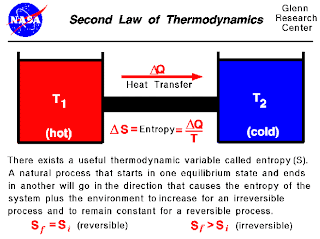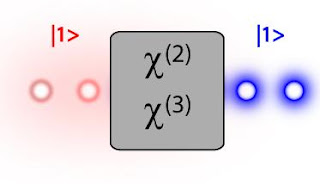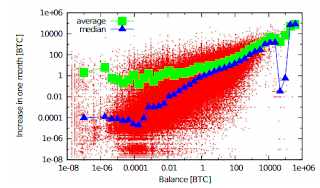One of the primary reason that stands out for the
transistor was driven by NASA and the need to reduce cargo space and increase computing power for orbital and
missions to the moon - before that,
slide rules. I know I just tweaked the die hard "conspiracy theorists" out there that don't believe we went to the moon, yet ardently believe Area 51 has aliens instead of high tech devoted to aerospace (see:
"Zero Dark Thirty" - they mentioned it) and the pyramids couldn't have been built by the same North African Egyptian architects the Romans thought enough of to "import" to the empire and build most of their modern architecture and technology: aqueducts, arches, obelisks (think Washington Monument); plumbing.
The conspiracy theorists, I feel, cling to their extravagant notions because: 1. They want to be the first to say "ah-ha! Told you so!" 2. They are making up for inadequacies in other life areas, like actually earning a degree. 3. It's a way not to face reality and put their gray matter to real world problems for which many of us...don't have easy answers.
The original Luddites
protested the advent of labor saving textile machines; riots broke out. Ultimately of course, capitalism with the assist of the English government won. I submit the Luddites should have fought hard not to break spindles, but for an equitable system of education and retraining, as we should here.
Technology replaces
the need for middle-level workers; confounds the romanticism of "working yourself up by your own bootstraps"; places stipulations on positions in the "minimum requirements" narrative description; encourages students to pursue at least a college degree. A robot can replace many workers that used to drill a widget: become the one who repairs the robot! We're in a dark balance of a moribund way to measure unemployment, as in you are unemployed if receiving a paycheck from the government; never a measure of an under-employment index, i.e. you're making less that you used to (found myself in that dilemma for a few years). To a certain extent, that's reflected in consumer confidence and purchasing patterns. Because of that previous wilderness experience, I am studying as my info to the right (see under E = MC
2) suggests; and due to lack of time or interest in fantasy, I don't engage much in conspiracy theories (they're not graded, not part of any interview process I'm aware of). Case in point: Texas Senator Ted Cruz actually being born in another country (Canada is: requires a passport to go to the Canadian side of Niagara Falls). He is a natural-born US citizen due to his mother's citizenship: if the current president had been born in Kenya (he was not); this logic would also apply to him. Karma always repays with irony.
Greed is keeping minimum wage minimum (thank God
Australia ignores our stellar inane example): some in the canopy of the economy would like to eliminate it entirely. That has the logic of a rain forest burning its own tree trunks to preserve leaves.
Our education system hasn't much modernized from its
Prussian model that prepared factory workers: it's no accident a factory is called a "campus"; you're encouraged to take career specific classes and be life-long learners; you have a defined lunch break/hour; bells trained us in school like Pavlov's dogs, herding us to and fro. We're renaming and reclaiming the
same insane testing regimen that no other country ahead of us in STEM graduates and careers follow. Initially, academies in the US were set up strictly along the color line vis-a-vis de jure segregation. I see no difference in its de facto modern incarnation. Some wishing for a utopia that never was has the same impact as
"Waiting for Godot."
At one end are so-called abstract tasks that require problem-solving, intuition, persuasion and creativity. These tasks are characteristic of professional, managerial, technical and creative occupations, like law, medicine, science, engineering, advertising and design. People in these jobs typically have high levels of education and analytical capability, and they benefit from computers that facilitate the transmission, organization and processing of information.
On the other end are so-called manual tasks, which require situational adaptability, visual and language recognition, and in-person interaction. Preparing a meal, driving a truck through city traffic or cleaning a hotel room present mind-bogglingly complex challenges for computers. But they are straightforward for humans, requiring primarily innate abilities like dexterity, sightedness and language recognition, as well as modest training. These workers can’t be replaced by robots, but their skills are not scarce, so they usually make low wages.
Computerization has therefore fostered a polarization of employment, with job growth concentrated in both the highest- and lowest-paid occupations, while jobs in the middle have declined. Surprisingly, overall employment rates have largely been unaffected in states and cities undergoing this rapid polarization. Rather, as employment in routine jobs has ebbed, employment has risen both in high-wage managerial, professional and technical occupations and in low-wage, in-person service occupations. (1)
This is a real-world problem, and testing regimens are not going to raise us out of it; fitting children through some predetermined model is not going to advance us; teaching made-up controversies about the origin of the universe, aliens, cabals and evolution aren't going to make us smarter: we'll just become more of a caricature as we fall further and further behind.
Sadly, this is not a new concept introduced in the NY Times (2); as Ecclesiastes said: "there are no new things under the sun."
So set your sights on the immediacy of now, o theorists!
Solve the Bermuda Triangle and Bigfoot later...
1. NY Times: How Technology Wrecks the Middle Class
2. James Boggs: The American Revolution - Pages From a Negro Worker's Notebook














